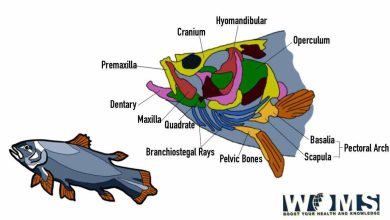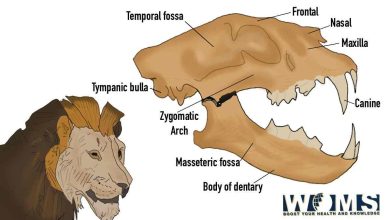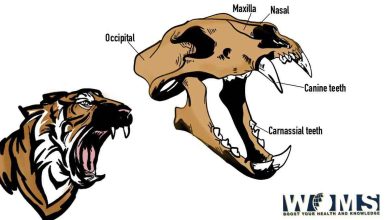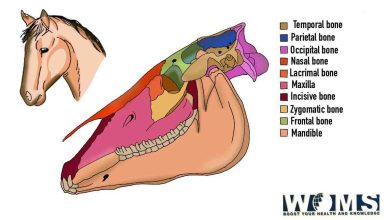Snake Skull Anatomy: Images and significance
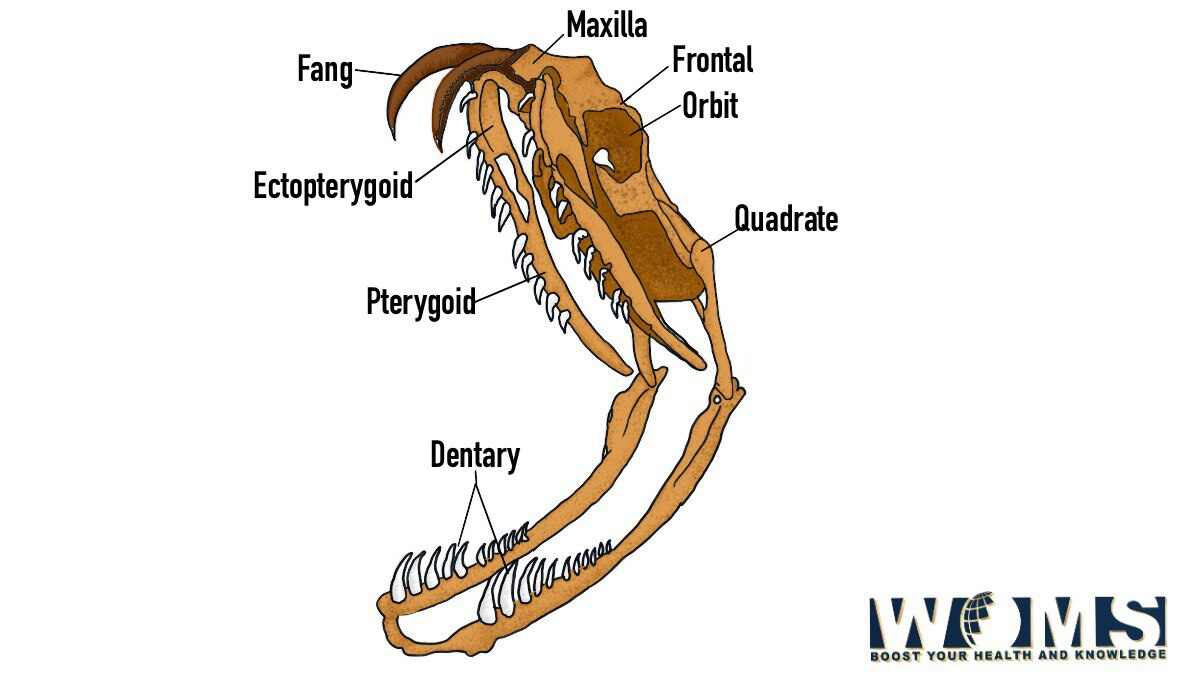
The snake skull is made of bone tissue and has a rigid brain vault that is joined to the remaining portion of the skull through ligaments. With their elongated bodies, lost limbs, and kinesis of the skull, snakes are among the greatest striking representations of how the vertebrates’ skeletal structure can change through time. Due to the lower jaw’s attachment to the back of the skull, the snake can extend its mouth considerably.
Although everyone is aware of how cunning snakes are, not everyone recognizes how interesting these poisonous creepy crawlies and other sliding slitherers are. We’ll go through some interesting information about snake skulls. We’ll also look at the stealthy creature’s unseen details.
An explanation about snakes
Snakes are classified as reptiles. They lack movable sternums, limbs, ear holes, and urinary bladder. The snake’s body is incredibly long and slender. As a result, the snake’s organs have become lengthened to suit its physique. Broad and pliable quadrate bones link the cranium to the lower jaw. Therefore, snakes cannot use their jaws to smash their victims. The victim must be eaten by the snake in its current form.
Reptiles can survive on land or in water, including snakes. The snake’s skeletal system is unique among the skeletons of the majority of vertebrates in that it lacks digits. The snake skull, vertebrae (up to 500), and ribs, that are attached to the vertebrae, comprise the majority of its structure. Snakes can move in several different strategies owing to their connected musculature, including slithering, swimming, throwing themselves out all over the soil, and gliding themselves to ascend tree branches. They can also move the organisms they have devoured down their bodies.
Certain snakes still possess pelvic bone fragments, including boas and pythons. The columella, a tiny bone with an in-ear that the snake employs to “hear” resonances across the soil surface, is a crucial bone in the snake’s skeletal system. To be able to consume creatures that are bigger than themselves, snakes have also evolved a specific sort of mouth comprised of skeletons joined by flexible connections. The jaw is also connected so that it can open widely, allowing the victim to cross past it, as well as subsequently move sideways to enable it to devour the victim.
Snake features and ecology
Let’s know the features and ecology of snakes along with snake skull. Snakes can be found in a diverse range of environments, comprising freshwater and saltwater ecosystems as well as woods, marshes, grasslands, and deserts. A few are awake at nighttime, while others are awake throughout the day.
As carnivores, snakes consume a diverse range of creatures, which include rats, flies, birds’ eggs, as well as infant birds. Since they have cold blood, snakes would travel to an atmosphere that will help them maintain a comfortable core temperature. They are seldom encountered in the public and cannot endure the intensely hot weather for longer than 10 to 20 minutes. They hibernate over the wintertime and might even occasionally go dormant during the scorching hot summertime. The majority of snakes individuals might come across are not dangerous.
Snake’s head
The anatomy of the skulls of most animals like the lion skull is identical to that of the polar bear. The cranium (brain case) and the jaw are the two basic components of these skulls (lower jaw). Additionally, there is the maxilla (upper jaw), although, in most animals, it is joined to the base of the skull to form a single, robust bone. Strong ligaments hold the mandible and skull together when they lock into place.
A skull is extremely strong and resilient because there are only two basic elements to it. This is crucial for all of the biting and chewing that we perform. We can’t open our mouths extremely wide because it also limits our ability to move.
Snakes, on the other hand, have a very distinctive cranium that is made up of several different bones. This makes the snake skull different. The cranium is likewise divided into two sections, along with the left and right sides of each of the upper and lower jaws. The flexible ligaments that hold the bones together prevent them from locking into place in the manner that the skulls of the majority of other animals do. As a result, the snake’s jaw may move extensively in all directions and its cranium is highly flexible.
Even the left and right sides of the mouth can move separately in snakes. They can gradually drag the food deeper into their mouth by gradually sliding one jaw forward while the other side holds the meal in place. The reason snakes can consume such enormous animals completely without employing their hands is due to this factor.
Joints of the snake skull
- The joint that connects the mandible to the quadrate. It is comparable to the joint in the jaws of mammals.
- The joint between the quadrate and the supratemporal. Since it can move quickly in all dimensions, the snake can expand its jaw wider and its jaws are more flexible.
- Around the joint where the maxilla and prefrontal bones meet. The intricate process by which the snake drags prey into its mouth is made easier by the maxilla’s ability to swivel in the plane of the photograph, even though it does not enhance the gape.
- The joint is at the junction of the frontal and nasal bones. It enables a little upturn of the nose, which widens the gap and makes swallowing easier.
Snake Skull Tattoo
Snake skull tattoos stand for change, development, and the end of one’s former self. The snake skull tattoo is a flexible means to demonstrate one’s knowledge and one’s historic origins. It is rooted in historical records but constantly transforms and changes into something new and amazing.
A stylish and artistic tattoo pattern option is a snake skull. A truly creative dual significance can be found in a snake skull tattoo. A snake skull tattoo is ideal for huge portions that combine with the remainder of the snake’s skeletal system or for simple designs that are placed in more intimate locations. The cobra skull tattoo is a representation of knowledge and a fair dosage of terror since it can look like a prize to get a deadly animal on one skin.
Tattoos with skulls are frequently linked to killing and human death rates, serving as yet another solemn awareness that we shall all pass away one day.
The interpretations of snake tattoos vary depending on the culture. Snake skull tattoos are a great option for individuals who have undergone a huge transition in their lives because they are commonly connected with regeneration and modification because snakes remove their epidermis.
Within a civilized culture, a skull and serpent are the main typical symbols of mortality and the loss of an individual’s biological and spiritual selves. A powerful representation of mortality under the grips of a dangerous monster is the snake coiling around the skull. The serpent or snake skull tattoo seems to have a snake motif and is typically associated with greater gothic significance and artistic expression. Mortality is represented by this tattoo, whereas information and secrets are represented by the snake. The tattoo overall symbolizes the retention of information after mortality when all the pieces are put together.
The significance of protecting and preserving snakes
Site clearance for farming, urban advancement, and the migration of creatures like household animals and cane toads have all led to the several snake species endangerment. Every life on planet Earth, such as humans, depends on keeping a significant amount of biodiversity, and snakes play a significant role in that richness.
Pests like rats and mice can be controlled by them. And to lessen the possibility of a potentially fatal encounter, several animals which are friendly to humans feed on toxic snakes. The advantages of snakes are now understood in several countries around the world.
Conclusion
Snake skulls differ from those of typical vertebrates being that their numerous skeletons are freely attached through flexible ligaments, enabling snakes to extend their jaws across larger living creatures. This large, unmounted snake skull, which is a specimen of a common non-venomous genus like Thamnophis, is perfect for close inspection. The hinged jaws can be used to show how snakes swallow large prey.
FAQs
What makes a snake skeleton distinct?
Snake skeletons are unusual for a variety of reasons. The number of vertebrae and ribs distinguish a snake’s skeleton from the skeletons of every other animal or reptile, as their adaptable spines, and virtually total absence of many other skeletal features.
Do snakes have skull bones?
Adult humans possess 206 bones, whereas snakes, based on their growth and breed, may comprise 300 or even more. Snakes only possess three distinct kinds of bones, in contrast to humans and the majority of mammals: the skull, jawbone, and backbone.
Are snakes venomous?
Pit vipers account for a great percentage of venomous bites, and rattlesnakes account for 50% of them. The greatest method for avoiding a bite from a snake is to leave it undisturbed since it won’t bite until they sense to attack. Do not handle any snake in the wild as they are still capable of biting.
